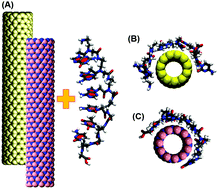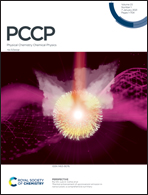Molecular insights on the dynamic stability of peptide nucleic acid functionalized carbon and boron nitride nanotubes†
Abstract
The strategic approaches to the design of self-assembled hybrids of biomolecular systems at the nanoscale such as deoxyribonucleic acid (DNA) with single-wall carbon nanotubes (CNTs) and their structural analog, boron nitride nanotubes (BNNTs), rely on understanding how biomolecules recognize and mediate intermolecular interactions with the nanomaterial's surface. In this paper, we consider peptide nucleic acid (PNA), which is a synthetic analog of DNA, and investigate its interaction with a zigzag CNT and BNNT of similar diameter. The results based on the molecular dynamics method find that PNA provides definitive contrasts in the adsorption on the tubular surface in aqueous solution: it prefers to wrap along the circumferential direction on a (11,0) CNT, whereas it binds along the axial direction adopting an extended configuration on a (11,0) BNNT. Moreover, gas-phase Monte Carlo simulations show a dependence of the nanotube diameter on the calculated adsorption energy, with BNNTs exhibiting higher adsorption energy compared to CNTs, and the largest-diameter (25,0) tubular configuration facilitates encapsulation of PNA rather than PNA being adsorbed on its sidewall. The results are expected to be of relevance in the design of novel PNA-based archetypal hybrid materials for nanoscale applications in health-related areas including biosensing.

- This article is part of the themed collection: 2021 PCCP HOT Articles


 Please wait while we load your content...
Please wait while we load your content...